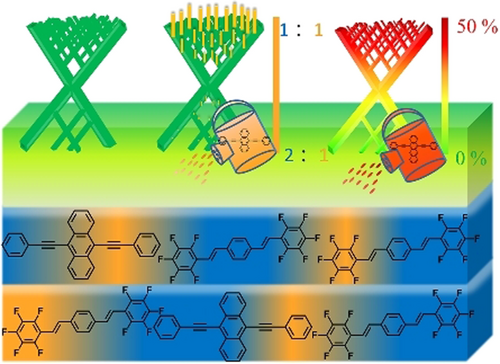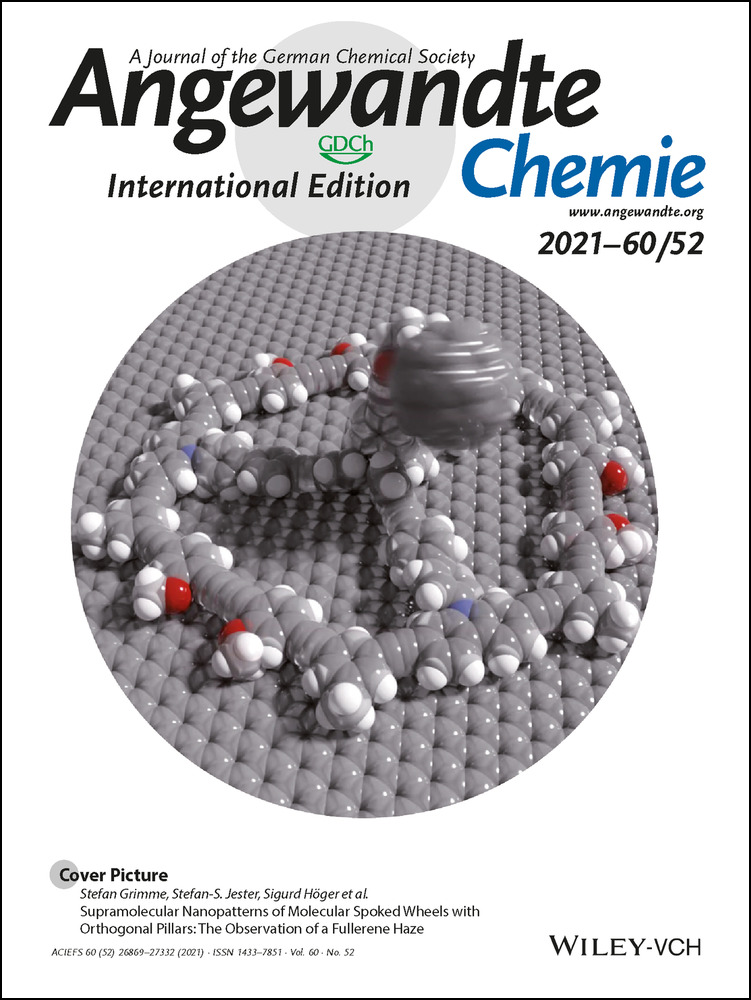Hyperbranched Microwire Networks of Organic Cocrystals with Optical Waveguiding and Light-Harvesting Abilities
Zuofang Feng
Department of Chemistry, School of Science, Tianjin University, Tianjin, 300072 P. R. China
Search for more papers by this authorTao Hai
Department of Chemistry, School of Science, Tianjin University, Tianjin, 300072 P. R. China
Search for more papers by this authorYin Liang
Department of Materials Science and Engineering, College of Engineering, Peking University, Beijing, 100871 P. R. China
Search for more papers by this authorProf. Dr. Qing Zhang
Department of Materials Science and Engineering, College of Engineering, Peking University, Beijing, 100871 P. R. China
Search for more papers by this authorCorresponding Author
Prof. Dr. Yilong Lei
Department of Chemistry, School of Science, Tianjin University, Tianjin, 300072 P. R. China
Search for more papers by this authorZuofang Feng
Department of Chemistry, School of Science, Tianjin University, Tianjin, 300072 P. R. China
Search for more papers by this authorTao Hai
Department of Chemistry, School of Science, Tianjin University, Tianjin, 300072 P. R. China
Search for more papers by this authorYin Liang
Department of Materials Science and Engineering, College of Engineering, Peking University, Beijing, 100871 P. R. China
Search for more papers by this authorProf. Dr. Qing Zhang
Department of Materials Science and Engineering, College of Engineering, Peking University, Beijing, 100871 P. R. China
Search for more papers by this authorCorresponding Author
Prof. Dr. Yilong Lei
Department of Chemistry, School of Science, Tianjin University, Tianjin, 300072 P. R. China
Search for more papers by this authorGraphical Abstract
Hierarchical micro- and nanostructures made of π-conjugated molecules are not yet reported due to the weak control over intermolecular interactions and little-known complex assembly behavior of organic species. Hyperbranched microwire networks comprising binary organic arene-perfluoroarene cocrystals were created, which show optical waveguiding and light-harvesting abilities.
Abstract
We report the synthesis of hyperbranched organic microwire (MW) networks comprising 1,4-bis(pentafluorostyryl)benzene (10Ft) and 9,10-bis(phenylethynyl)anthracene (BA) using a simple solution co-assembly route. Pure 10Ft or BA assemblies cannot produce such complex MW networks; in contrast with a binary cocrystal of 10Ft and BA with a 2:1 molar ratio ((2:1)10Ft:BA), which is formed via intermolecular arene-perfluoroarene (AP) interactions. A new generation of multiple MWs grow epitaxially on the previous generation of MWs to form MW arrays in which BA may also act as an intermediate product to facilitate the regeneration of (2:1)10Ft:BA. Highly aligned and well-connected MW networks enable superior optical waveguiding ability. Moreover, a red-emitting dopant, 5,12-bis(phenylethynyl)naphthacene (BN) was incorporated into (2:1)10Ft:BA host MWs, giving light-harvesting hierarchical MW networks via an energy-transfer (ET) process. The realization of the hyperbranched MWs provides us with deep insight into the rational creation of complex branched arrays from functional organic cocrystals.
Conflict of interest
The authors declare no conflict of interest.
Supporting Information
As a service to our authors and readers, this journal provides supporting information supplied by the authors. Such materials are peer reviewed and may be re-organized for online delivery, but are not copy-edited or typeset. Technical support issues arising from supporting information (other than missing files) should be addressed to the authors.
| Filename | Description |
|---|---|
| anie202111856-sup-0001-cif.zip263.6 KB | Supporting Information |
| anie202111856-sup-0001-misc_information.pdf3 MB | Supporting Information |
| anie202111856-sup-0001-Video_S1.mp45.2 MB | Supporting Information |
| anie202111856-sup-0001-Video_S2.mp49 MB | Supporting Information |
| anie202111856-sup-0001-Video_S3.mp47.2 MB | Supporting Information |
Please note: The publisher is not responsible for the content or functionality of any supporting information supplied by the authors. Any queries (other than missing content) should be directed to the corresponding author for the article.
References
- 1D. Wang, F. Qian, C. Yang, Z. Zhong, C. M. Lieber, Nano Lett. 2004, 4, 871–874.
- 2D. J. Milliron, S. M. Hughes, Y. Cui, L. Manna, J. Li, L.-W. Wang, A. P. Alivisatos, Nature 2004, 430, 190–195.
- 3C. Cheng, H. J. Fan, Nano Today 2012, 7, 327–343.
- 4H. Yan, R. He, J. Johnson, M. Law, R. J. Saykally, P. Yang, J. Am. Chem. Soc. 2003, 125, 4728–4729.
- 5S. H. Ko, D. Lee, H. M. Kang, K. H. Nam, J. Y. Yeo, S. J. Hong, C. P. Grigoropoulos, H. J. Sung, Nano Lett. 2011, 11, 666–671.
- 6C. Cheng, B. Liu, H. Yang, W. Zhou, L. Sun, R. Chen, S. F. Yu, J. Zhang, H. Gong, H. Sun, H. J. Fan, ACS Nano 2009, 3, 3069–3076.
- 7J. Doherty, S. Biswas, D. McNulty, C. Downing, S. Raha, C. O'Regan, A. Singha, C. O'Dwyer, J. D. Holmes, Chem. Mater. 2019, 31, 4016–4024.
- 8X. Jiang, B. Tian, J. Xiang, F. Qian, G. Zheng, H. Wang, L. Mai, C. M. Lieber, Proc. Natl. Acad. Sci. USA 2011, 108, 12212–12216.
- 9K. A. Dick, K. Deppert, M. W. Larsson, T. Mårtensson, W. Seifert, L. R. Wallenberg, L. Samuelson, Nat. Mater. 2004, 3, 380–384.
- 10R. Liu, Z.-A. Li, C. Zhang, X. Wang, M. A. Kamran, M. Farle, B. Zou, Nano Lett. 2013, 13, 2997–3001.
- 11W.-Q. Wu, H.-S. Rao, H.-L. Feng, H.-Y. Chen, D.-B. Kuang, C.-Y. Su, Nano Energy 2014, 9, 15–24.
- 12R. Yang, Y. L. Chueh, J. R. Morber, R. Snyder, L. J. Chou, Z. L. Wang, Nano Lett. 2009, 9, 1764–1769.
- 13M. J. Bierman, S. Jin, Energy Environ. Sci. 2009, 2, 1050–1059.
- 14M. J. Bierman, Y. K. Albert Lau, S. Jin, Nano Lett. 2007, 7, 2907–2912.
- 15J. Zhu, H. Peng, C. K. Chan, K. Jarausch, X. F. Zhang, Y. Cui, Nano Lett. 2007, 7, 1095–1099.
- 16J. Zhu, H. Peng, A. F. Marshall, D. M. Barnett, W. D. Nix, Y. Cui, Nat. Nanotechnol. 2008, 3, 477–481.
- 17K. Takazawa, Y. Kitahama, Y. Kimura, G. Kido, Nano Lett. 2005, 5, 1293–1296.
- 18W. Yao, Y. Yan, L. Xue, C. Zhang, G. Li, Q. Zheng, Y. S. Zhao, H. Jiang, J. Yao, Angew. Chem. Int. Ed. 2013, 52, 8713–8717; Angew. Chem. 2013, 125, 8875–8879.
- 19Y. S. Zhao, H. Fu, A. Peng, Y. Ma, Q. Liao, J. Yao, Acc. Chem. Res. 2010, 43, 409–418.
- 20Y. Wu, J. Feng, X. Jiang, Z. Zhang, X. Wang, B. Su, L. Jiang, Nat. Commun. 2015, 6, 6737.
- 21Z. Y. Yu, Y. S. Wu, L. Xiao, J. Chen, Q. Liao, J. Yao, H. Fu, J. Am. Chem. Soc. 2017, 139, 6376–6381.
- 22W. Zhang, Y. Yan, J. Gu, J. Yao, Y. S. Zhao, Angew. Chem. Int. Ed. 2015, 54, 7125–7129; Angew. Chem. 2015, 127, 7231–7235.
- 23S. Chen, P. Slattum, C. Wang, L. Zang, Chem. Rev. 2015, 115, 11967–11998.
- 24L. Jiang, Y. Fu, H. Li, W. Hu, J. Am. Chem. Soc. 2008, 130, 3937–3941.
- 25R. Li, W. P. Hu, Y. Liu, D. Zhu, Acc. Chem. Res. 2010, 43, 529–540.
- 26Q. Kong, Q. Liao, Z. Xu, X. Wang, J. Yao, H. Fu, J. Am. Chem. Soc. 2014, 136, 2382–2388.
- 27Y. Zhang, Q. Liao, X. Wang, J. Yao, H. Fu, Angew. Chem. Int. Ed. 2017, 56, 3616–3620; Angew. Chem. 2017, 129, 3670–3674.
- 28D. Zhang, J. De, Y. Lei, H. Fu, Nat. Commun. 2021, 12, 1838.
- 29C. C. Yang, L. Gu, C. Q. Ma, M. X. Gu, X. J. Xie, H. F. Shi, H. L. Ma, W. Yao, Z. F. An, W. Huang, Mater. Horiz. 2019, 6, 984–989.
- 30L. J. Bu, E. Pentzer, F. A. Bokel, T. Emrick, R. C. Hayward, ACS Nano 2012, 6, 10924–10929.
- 31C. R. Patrick, G. S. Prosser, Nature 1960, 187, 1021.
- 32Y. Sun, Y. Lei, L. Liao, W. Hu, Angew. Chem. Int. Ed. 2017, 56, 10352–10356; Angew. Chem. 2017, 129, 10488–10492.
- 33G. C. Coates, A. R. Dunn, L. M. Henling, D. A. Dougherty, R. H. Grubbs, Angew. Chem. Int. Ed. Engl. 1997, 36, 248–251; Angew. Chem. 1997, 109, 290–293.
- 34A. Friedrich, I. E. Collings, K. F. Dziubek, S. Fanetti, K. Radacki, J. Ruiz-Fuertes, J. Pellicer-Porres, M. Hanfland, D. Sieh, R. Bini, S. J. Clark, T. B. Marder, J. Am. Chem. Soc. 2020, 142, 18907–18923.
- 35M. Morimoto, M. Irie, J. Am. Chem. Soc. 2010, 132, 14172–14178.
- 36S. Y. Park, J. H. Kim, S. Y. Park, Adv. Mater. 2018, 30, 1704759.
- 37C. Wang, H. Dong, H. Li, H. Zhao, Q. Meng, W. Hu, Cryst. Growth Des. 2010, 10, 4155–4160.
- 38C. Wang, Y. Liu, Z. Ji, E. Wang, R. Li, H. Jiang, Q. Tang, H. Li, W. Hu, Chem. Mater. 2009, 21, 2840–2845.
- 39Y. Sun, Y. Lei, W. Hu, W.-Y. Wong, J. Am. Chem. Soc. 2020, 142, 7265–7269.
- 40A. Mandal, A. Choudhury, P. K. Iyer, P. Mal, J. Phys. Chem. C 2019, 123, 18198–18206.
- 41K. Liu, Y. Lei, H. Fu, Chem. Mater. 2020, 32, 5162–5172.
- 42K. Iwai, H. Yamagishi, C. Herzberger, Y. Sato, H. Tsuji, K. Albrecht, K. Yamamoto, F. Sasaki, H. Sato, A. Asaithambi, A. Lorke, Y. Yamamoto, Angew. Chem. Int. Ed. 2020, 59, 12674–12679; Angew. Chem. 2020, 132, 12774–12779.
- 43J. Chen, Y. Fu, L. Samad, L. Dang, Y. Zhao, S. Shen, L. Guo, S. Jin, Nano Lett. 2017, 17, 460–466.
- 44J. Chen, Z. Luo, Y. Fu, X. Wang, K. J. Czech, S. Shen, L. Guo, J. C. Wright, A. Pan, S. Jin, ACS Energy Lett. 2019, 4, 1045–1052.
- 45Y. Hao, C. Ding, T. Lu, L. Xie, P. Nan, S. Guo, X. Wang, A. Li, X. Xu, B. Zou, R. Liu, Adv. Opt. Mater. 2020, 8, 1901644.
- 46D. Okada, T. Nakamura, D. Braam, T. D. Dao, S. Ishii, T. Nagao, A. Lorke, T. Nabeshima, Y. Yamamoto, ACS Nano 2016, 10, 7058–7063.
- 47Hendra, A. Takeuchi, H. Yamagishi, O. Oki, M. Morimoto, M. Irie, Y. Yamamoto, Adv. Funct. Mater. 2021, 31, 2103685.
- 48Y. Lei, Y. Sun, Y. Zhang, H. Zhang, H. Zhang, Z. Meng, W.-Y. Wong, J. Yao, H. Fu, Nat. Commun. 2018, 9, 4358.





